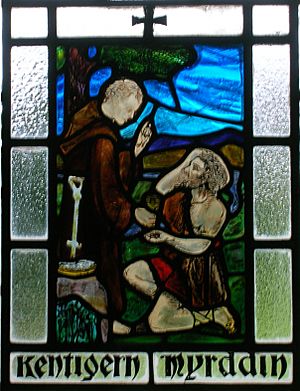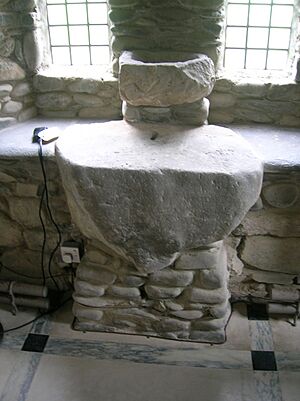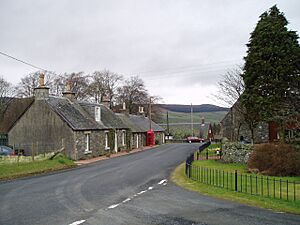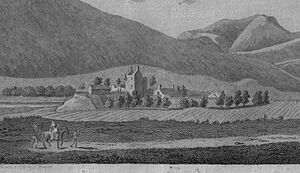Drumelzier facts for kids
Drumelzier is a small village and parish located in the Scottish Borders. It sits in the beautiful Tweed Valley and is known for its history and legends.
The area around Drumelzier is quite spread out. It includes smaller places like Wrae, Stanhope, Mossfennan, and Kingledoors. To the north, you'll find Broughton, and to the south, the road goes past Crook Inn towards Tweedsmuir. A stream called Powsail Burn (also known as Drumelzier Burn) flows through the village and joins the River Tweed. You can also find the Stobo Castle hotel and Dawyck Botanic Garden nearby. Dawyck is one of the special "Regional Gardens" connected to the Royal Botanic Garden Edinburgh.
Contents
History of Drumelzier
What's in a Name?
The name Drumelzier has changed over many years. Around 1200, it was called Dunmedler. Later, it became Dumelliare (1305), Drummeiller (1326), and Drummelzare (1492). By 1790, it was known as Drummelzier.
Some people think the name comes from an old Gaelic word meaning 'bare hill'. Another idea is that the village was named after Meldred. He was a local leader from the 500s who might have lived at Tinnis Castle.
The way we say Drumelzier today, /drəˈmɛljər/, comes from its old Scots spelling. It used to have a special letter called yogh, which looked a bit like a 'z'.
Old Castles of the Area
Drumelzier Castle
The village gets its name from Drumelzier Castle. This old castle was very close to the River Tweed. It was the original home of the Clan Tweedie family. They were given the land around 1320. The castle was also one of many peel towers built along the Tweed Valley to protect the area.
Today, only parts of the old castle remain. Modern farm buildings have been built using stones from the castle. The Tweedie family's wealth decreased over time. In 1633, the last Tweedie of Drumelzier had to sell the land to Lord Hay of Yester. The current owner of Drumelzier is Alexander Hay, who lives at Duns Castle.
The castle was left to fall apart and became a source of building stone. The main tower was still standing tall in 1972. However, most of it has since been taken down for safety reasons. Now, only a small, rubble-filled part of the tower is left.
Tinnis Castle
Above the village, there is a unique conical hill called 'Tinnis Castle'. This name comes from 'Thanes Castle'. When Francis Grose visited in 1790, only a few walls of the old fort were left. It was used as a stronghold by the Lords of Tweedie. Later, it passed to the Hay family through marriage.
Tinnis Castle was likely built in the late 1400s or early 1500s. It might have been built by the Tweedie family from nearby Drumelzier. The remains show it was a rectangular castle with walls surrounding a courtyard. There was a tower-house in one corner and round towers at other corners.
An old story from the 1600s says that Tinnis Castle was blown up. This happened during a fight between the Fleming family and the Tweedies of Drumelzier. However, in 1592, King James VI ordered the castle to be destroyed. This was because its owner, James Stewart, helped Earl Bothwell in his attack on Falkland Palace.
Merlin and Drumelzier's Magic
In local stories, people say that Merlin, the famous wizard from Arthurian legend, was held captive here. The enchantress Morgan le Fay supposedly trapped him inside a tree by a riverbank. Many old sites can be found in this area, from Bronze Age forts to medieval castles.


'Myrddin Wyllt', also known as 'Merlinus Caledonensis', was a real person from old Brythonic legends. He lived around 540-584 AD. He was seen as a prophet, a wild man, and a bard. He is often thought of as an early version of the Merlin we know from Arthurian stories.
In Welsh legends, Merlin is said to have been born in Carmarthen, South Wales. Some believe the town was named after him. Stories about Myrddin Wyllt's life are found in the Black Book of Carmarthen (written around 1250 AD). In these Welsh tales, he is described as a wild man of the woods, a prophet, and a Bard.
A 12th-century story, Vita Merlini Silvestris, calls him Lailoken. He was a warrior who was so shocked by a terrible battle in 573 AD that he ran away. He went to live as a wild man in the Caledonian Forest. In this story, Lailoken is captured by a local king named Meldred. Lailoken's wildness gave him the power to see the future. King Meldred kept him in his fort at Drumeller, hoping to get prophecies from him.
During talks about his freedom, Lailoken pointed out a leaf on the queen's scarf. He said it proved she had met her lover in the king's garden. Lailoken was set free, but the queen got her revenge. She arranged for shepherds to ambush and kill him.
Merlin Sylvestris was baptized and became a Christian by Saint Kentigern at an 'altarstone' near the village. It's also said that he died here in a strange way, through his 'three deaths'. Legend says he even predicted his own death.
Meldred buried Lailoken in the churchyard west of his fort. This spot was close to where the Powsail Burn (now called Drumelzier Burn) joins the River Tweed. In 1715, a man named Pennicuick said Merlin was buried a little below the churchyard, by the Powsail Burn. A local minister even showed him the exact spot, marked by a thorn tree.
There's a famous prophecy about this spot:
|
"When Tweed and Powsail meet at Merlin's grave, |
This prophecy came true on the very day James VI of Scotland and I of England was crowned King of both Scotland and England. The River Tweed flooded its banks and met the Powsail Burn at Merlin's Grave. People say it had never happened before and hasn't happened since!
The River Tweed Spirit
Ancient Celtic people believed that rivers had spirits. They thought they needed to keep these spirits happy, sometimes with offerings.
There's a rhyme about the River Tweed and a nearby river called the Till:
|
Tweed said to Till, |
The Tweed river is wide and shallow, while the Till is deep and narrow. This rhyme means that even though the Tweed flows faster, the Till is more dangerous because it's deeper.
A local story tells of a Baron of Drumelzier who came home after a long time away fighting in the Crusades. He found his wife with a new baby. His wife explained that one day she was walking by the Tweed river when the river spirit appeared and they had a child together. The Baron seemed to accept this story. However, local people were less convinced. They started calling the child 'Tweedie', and this became the family name for the Barons of Drumelzier.
A Glimpse into the Past
As late as 1598, people in Drumelzier would light Beltane fires on the local hills on the first day of May. This was an old pagan tradition. However, at that time, the church leaders put several people on trial for doing this.
|
See also
 In Spanish: Drumelzier para niños
In Spanish: Drumelzier para niños



